What is Trojan.HTML.FakeAlert? Trojan.HTML.FakeAlert is a dangerous security threat. If anti-virus detects this threat in the web pages that you open in the Internet Explorer, Google Chrome, Edge and Mozilla Firefox then it means that a malicious software get installed on your personal computer. Most often, anti-virus can remove harmful code (Trojan.HTML.FakeAlert itself) from web pages, but can not always find and remove malicious software that inject this harmful code to the web pages you are viewing.
The Trojan.HTML.FakeAlert virus can hide itself in the PC system’s memory and files, alter some computer settings and block them from changing. Also this virus may download and install: internet browser extensions that will insert undesired ads within the MS Edge, Mozilla Firefox, Internet Explorer and Google Chrome’s screen; a browser hijacker that will alter web browser’s home page and search engine.
Moreover, the Trojan.HTML.FakeAlert virus be able to gather lots of marketing-type data about you. This privacy info, in the future, can be transferred to third parties. What creates the risk of theft of marketing-type data about you
Don’t panic because we have got the method. Here’s a few simple steps on how to delete any malware and thereby get rid of Trojan.HTML.FakeAlert from your computer for free.
Remove Trojan.HTML.FakeAlert virus (Removal guide)
Fortunately, we’ve an effective solution that will assist you manually or/and automatically delete Trojan.HTML.FakeAlert from your computer and bring your computer settings back to normal. Below you will find a removal instructions with all the steps you may need to successfully delete this virus and its traces. Read it once, after doing so, please print this page as you may need to shut down your web browser or restart your computer.
To remove Trojan.HTML.FakeAlert, execute the following steps:
- Uninstall questionable apps using Windows Control Panel
- Remove Trojan.HTML.FakeAlert with Zemana Free
- Delete Trojan.HTML.FakeAlert virus and malicious extensions with HitmanPro
- Use MalwareBytes to delete Trojan.HTML.FakeAlert
- Delete Trojan.HTML.FakeAlert virus from IE
- Get rid of Trojan.HTML.FakeAlert virus from Chrome
- Get rid of Trojan.HTML.FakeAlert virus from Firefox
- How to stay safe online
- To sum up
Uninstall questionable apps using Windows Control Panel
Some potentially unwanted apps, browser hijacking apps and ad supported software can be deleted by uninstalling the free programs they came with. If this way does not succeed, then looking them up in the list of installed software in MS Windows Control Panel. Use the “Uninstall” command in order to remove them.
Windows 10, 8.1, 8
Click the Microsoft Windows logo, and then press Search ![]() . Type ‘Control panel’and press Enter as displayed in the following example.
. Type ‘Control panel’and press Enter as displayed in the following example.

Once the ‘Control Panel’ opens, click the ‘Uninstall a program’ link under Programs category as displayed below.

Windows 7, Vista, XP
Open Start menu and choose the ‘Control Panel’ at right as shown on the screen below.

Then go to ‘Add/Remove Programs’ or ‘Uninstall a program’ (Windows 7 or Vista) as shown in the figure below.

Carefully browse through the list of installed software and get rid of all suspicious and unknown programs. We advise to click ‘Installed programs’ and even sorts all installed applications by date. Once you have found anything questionable that may be the virus and other security threats or other potentially unwanted application (PUA), then select this program and press ‘Uninstall’ in the upper part of the window. If the questionable application blocked from removal, then run Revo Uninstaller Freeware to fully delete it from your computer.
Remove Trojan.HTML.FakeAlert with Zemana Free
We recommend using the Zemana Anti-Malware (ZAM) which are completely clean your machine of the virus. The tool is an advanced malware removal application created by (c) Zemana lab. It is able to help you delete PUPs, viruss, adware, malware, toolbars, ransomware and other security threats from your system for free.
Now you can install and use Zemana Free to get rid of Trojan.HTML.FakeAlert from your system by following the steps below:
Please go to the link below to download Zemana Anti-Malware (ZAM) setup file named Zemana.AntiMalware.Setup on your personal computer. Save it to your Desktop.
164815 downloads
Author: Zemana Ltd
Category: Security tools
Update: July 16, 2019
Launch the installer after it has been downloaded successfully and then follow the prompts to set up this utility on your system.

During installation you can change some settings, but we suggest you do not make any changes to default settings.
When setup is complete, this malicious software removal tool will automatically launch and update itself. You will see its main window as shown on the screen below.

Now click the “Scan” button for checking your computer for the Trojan.HTML.FakeAlert and other malware and potentially unwanted applications. While the Zemana AntiMalware tool is checking, you can see count of objects it has identified as being infected by malicious software.

After the scan get completed, you’ll be opened the list of all found threats on your system. Next, you need to click “Next” button.

The Zemana Free will remove Trojan.HTML.FakeAlert and move items to the program’s quarantine. After the cleaning process is done, you may be prompted to reboot your machine to make the change take effect.
Delete Trojan.HTML.FakeAlert virus and malicious extensions with HitmanPro
The Hitman Pro utility is free and easy to use. It may scan and remove virus and other malware and potentially unwanted programs, malware, PUPs and ad-supported software from system (Microsoft Windows 10, 8, 7, XP) and thereby restore web-browsers default settings (startpage, search engine and newtab page). HitmanPro is powerful enough to look for and remove malicious registry entries and files that are hidden on the computer.
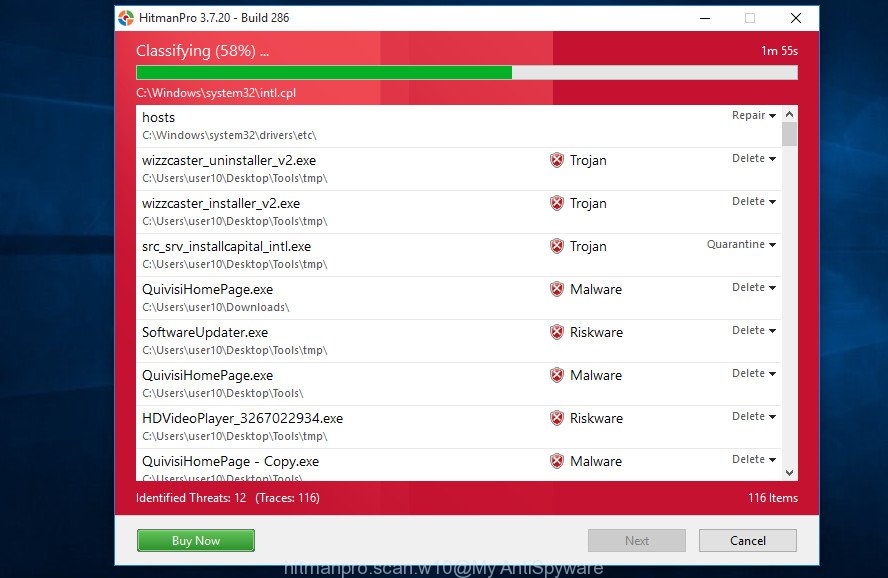
- Installing the Hitman Pro is simple. First you’ll need to download Hitman Pro on your system by clicking on the following link.
- When the download is done, double click the HitmanPro icon. Once this utility is opened, press “Next” button to perform a system scan with this utility for the Trojan.HTML.FakeAlert and other kinds of potential threats. A scan can take anywhere from 10 to 30 minutes, depending on the count of files on your PC and the speed of your computer. While the Hitman Pro program is checking, you can see number of objects it has identified as threat.
- When finished, HitmanPro will open you the results. When you’re ready, click “Next” button. Now click the “Activate free license” button to start the free 30 days trial to remove all malicious software found.
Use MalwareBytes to delete Trojan.HTML.FakeAlert
Remove Trojan.HTML.FakeAlert virus manually is difficult and often the virus is not completely removed. Therefore, we suggest you to use the MalwareBytes AntiMalware which are completely clean your computer. Moreover, the free program will help you to get rid of malware, potentially unwanted software, toolbars and adware that your personal computer may be infected too.
Please go to the following link to download MalwareBytes Free. Save it on your MS Windows desktop or in any other place.
327072 downloads
Author: Malwarebytes
Category: Security tools
Update: April 15, 2020
After downloading is done, close all windows on your system. Further, run the file called mb3-setup. If the “User Account Control” prompt pops up like below, click the “Yes” button.

It will open the “Setup wizard” that will help you install MalwareBytes on the PC. Follow the prompts and don’t make any changes to default settings.
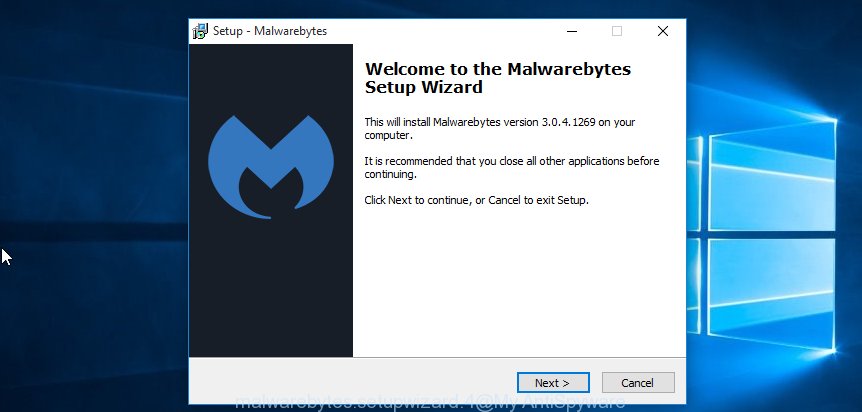
Once install is finished successfully, click Finish button. Then MalwareBytes AntiMalware (MBAM) will automatically launch and you can see its main window like below.
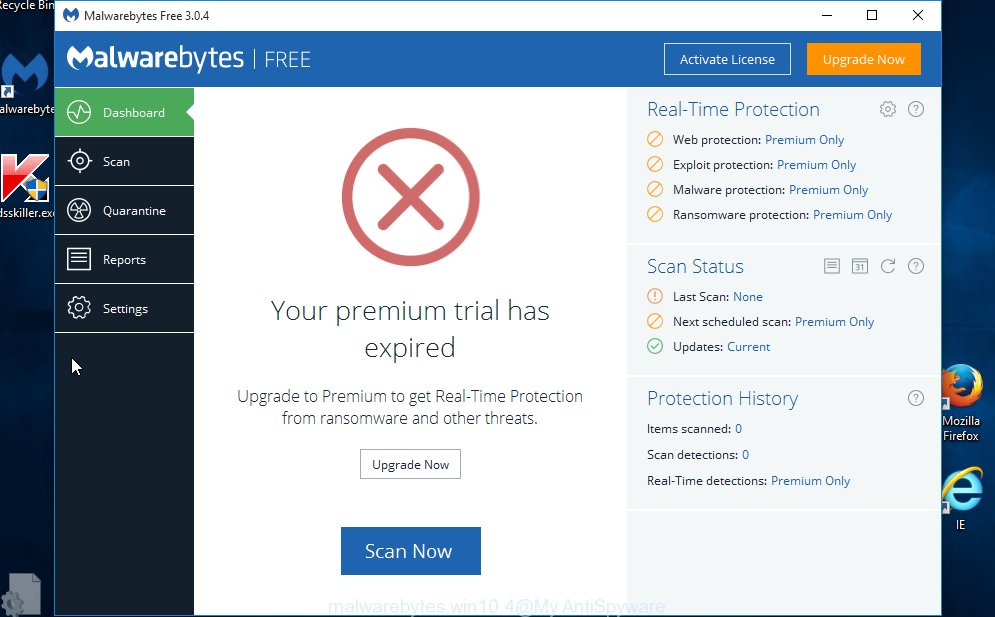
Next, click the “Scan Now” button to search for the Trojan.HTML.FakeAlert malware. Depending on your personal computer, the scan can take anywhere from a few minutes to close to an hour. While the MalwareBytes Anti Malware (MBAM) is checking, you may see number of objects it has identified either as being malicious software.
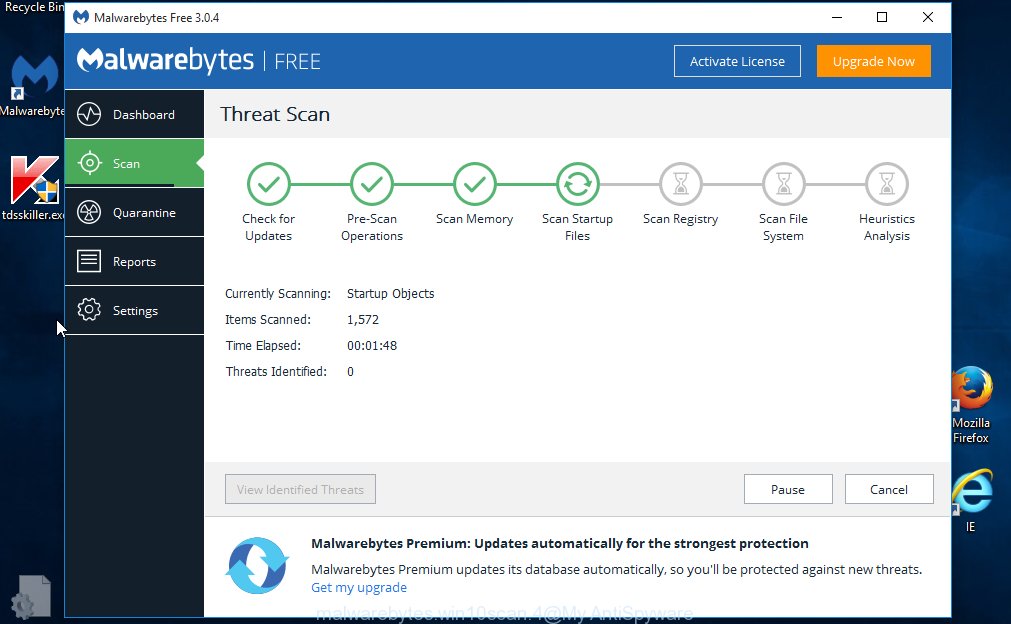
Once the scan is done, you can check all threats found on your computer. In order to get rid of all threats, simply click “Quarantine Selected” button.
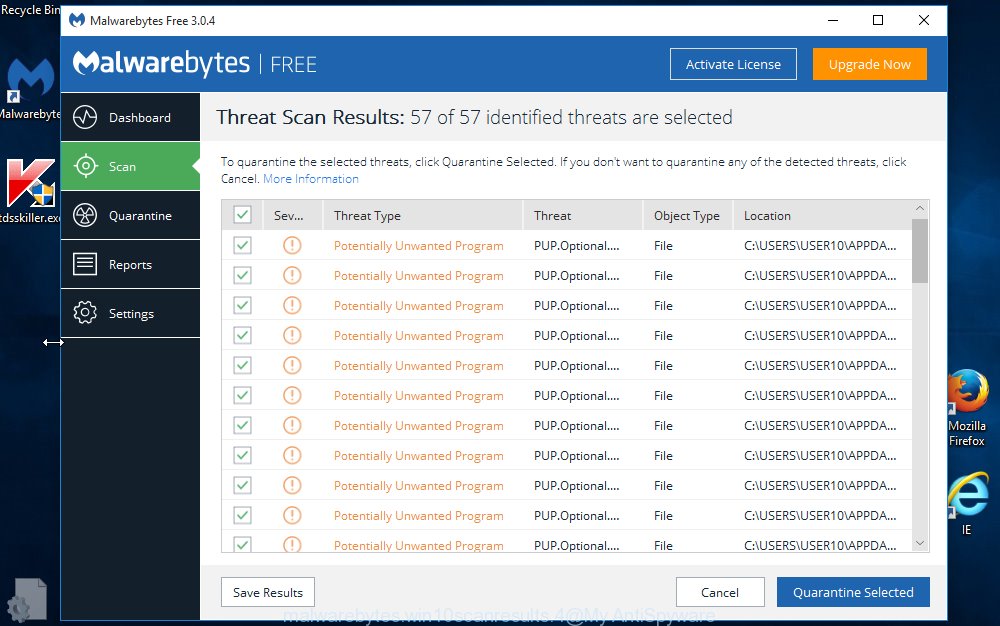
The MalwareBytes Free will start to delete Trojan.HTML.FakeAlert and other malicious software. Once finished, you may be prompted to reboot your computer. We advise you look at the following video, which completely explains the procedure of using the MalwareBytes Anti-Malware to get rid of browser hijackers, adware and other malicious software.
Delete Trojan.HTML.FakeAlert virus from IE
By resetting Internet Explorer browser you return your web-browser settings to its default state. This is basic when troubleshooting problems that might have been caused by the Trojan.HTML.FakeAlert .
First, launch the Internet Explorer, click ![]() ) button. Next, press “Internet Options” as shown in the following example.
) button. Next, press “Internet Options” as shown in the following example.

In the “Internet Options” screen select the Advanced tab. Next, click Reset button. The Internet Explorer will show the Reset Internet Explorer settings prompt. Select the “Delete personal settings” check box and press Reset button.

You will now need to reboot your computer for the changes to take effect. It will get rid of virus and other kinds of potential threats like malicious software and PUPs, disable malicious and ad-supported internet browser’s extensions and restore the IE’s settings like newtab, search engine by default and start page to default state.
Get rid of Trojan.HTML.FakeAlert virus from Chrome
Like other modern internet browsers, the Chrome has the ability to reset the settings to their default values and thereby recover the web browser new tab page, homepage and search provider that have been replaced by the Trojan.HTML.FakeAlert virus.

- First, start the Google Chrome and click the Menu icon (icon in the form of three dots).
- It will open the Chrome main menu. Choose More Tools, then press Extensions.
- You will see the list of installed addons. If the list has the plugin labeled with “Installed by enterprise policy” or “Installed by your administrator”, then complete the following steps: Remove Chrome extensions installed by enterprise policy.
- Now open the Chrome menu once again, click the “Settings” menu.
- Next, click “Advanced” link, which located at the bottom of the Settings page.
- On the bottom of the “Advanced settings” page, click the “Reset settings to their original defaults” button.
- The Chrome will open the reset settings prompt as on the image above.
- Confirm the web-browser’s reset by clicking on the “Reset” button.
- To learn more, read the blog post How to reset Chrome settings to default.
Get rid of Trojan.HTML.FakeAlert virus from Firefox
Resetting your Mozilla Firefox is good initial troubleshooting step for any issues with your web-browser program. Essential information like bookmarks, browsing history, passwords, cookies, auto-fill data and personal dictionaries will not be removed.
Click the Menu button (looks like three horizontal lines), and click the blue Help icon located at the bottom of the drop down menu as on the image below.

A small menu will appear, press the “Troubleshooting Information”. On this page, click “Refresh Firefox” button as displayed on the screen below.

Follow the onscreen procedure to return your Mozilla Firefox web-browser settings to their original settings.
How to stay safe online
By installing an ad-blocking program such as AdGuard, you are able to stop malicious pages, autoplaying video ads and get rid of a huge number of distracting and undesired ads on sites.
AdGuard can be downloaded from the following link. Save it on your MS Windows desktop.
26843 downloads
Version: 6.4
Author: © Adguard
Category: Security tools
Update: November 15, 2018
Once the downloading process is finished, double-click the downloaded file to start it. The “Setup Wizard” window will show up on the computer screen like below.

Follow the prompts. AdGuard will then be installed and an icon will be placed on your desktop. A window will show up asking you to confirm that you want to see a quick guidance like below.

Press “Skip” button to close the window and use the default settings, or click “Get Started” to see an quick guide which will assist you get to know AdGuard better.
Each time, when you run your computer, AdGuard will start automatically and stop unwanted advertisements, as well as other harmful or misleading web-pages. For an overview of all the features of the program, or to change its settings you can simply double-click on the AdGuard icon, which is located on your desktop.
To sum up
After completing the guidance above, your PC should be clean from the Trojan.HTML.FakeAlert and other malicious software. Your antivirus will no longer detect any security threats. Unfortunately, if the steps does not help you, then you have caught a new malware, and then the best way – ask for help.
Please create a new question by using the “Ask Question” button in the Questions and Answers. Try to give us some details about your problems, so we can try to help you more accurately. Wait for one of our trained “Security Team” or Site Administrator to provide you with knowledgeable assistance tailored to your problem with the Trojan.HTML.FakeAlert virus.


















